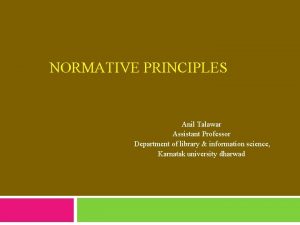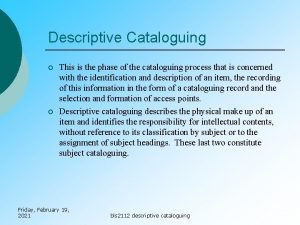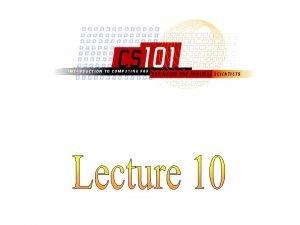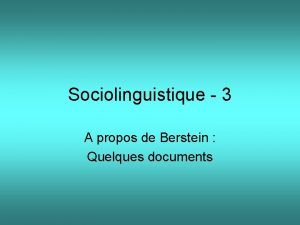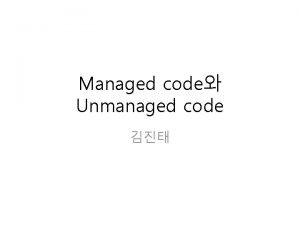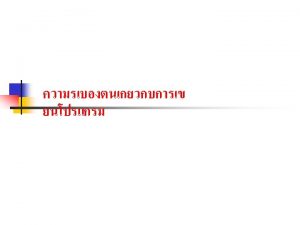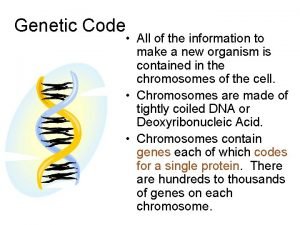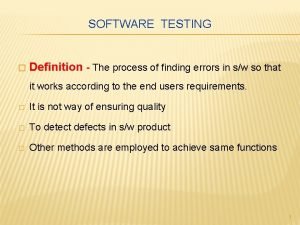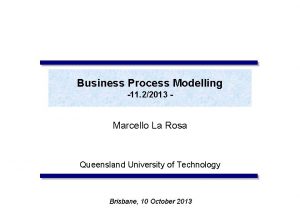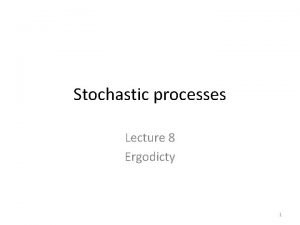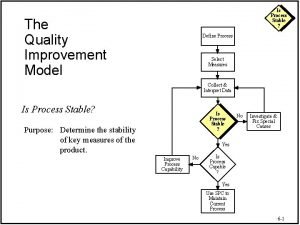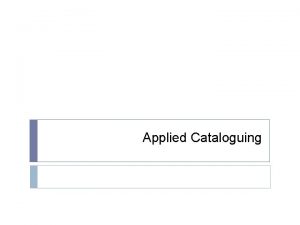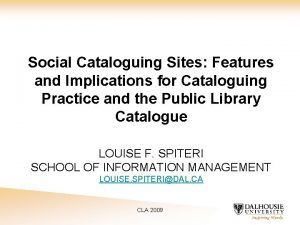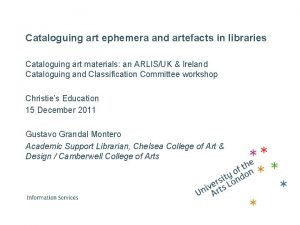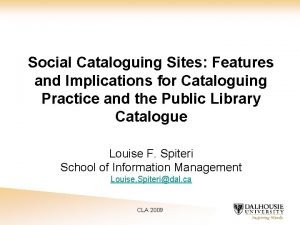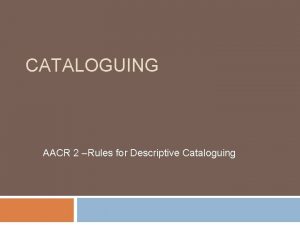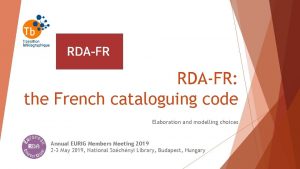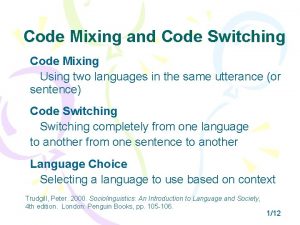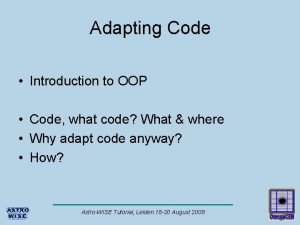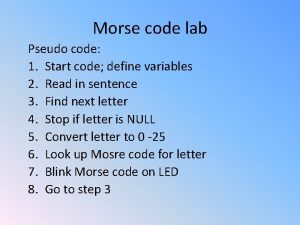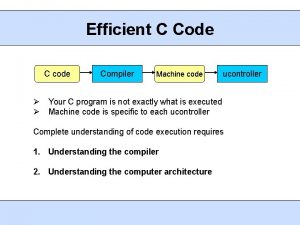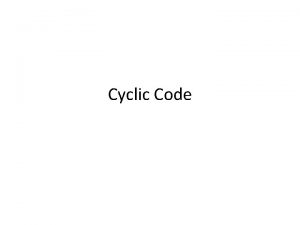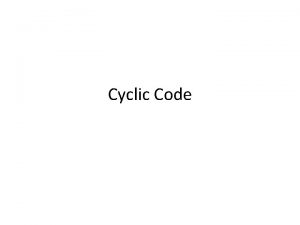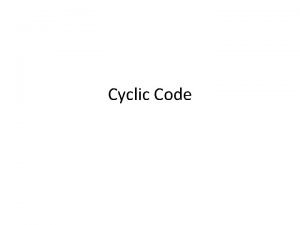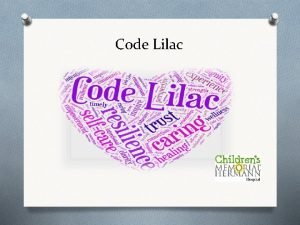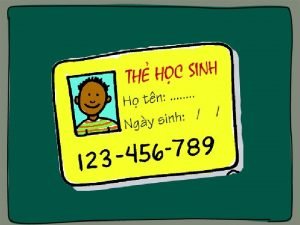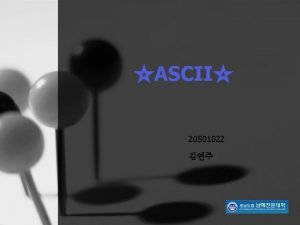Cataloguing Code and Cataloguing Process What is a




















- Slides: 20

Cataloguing Code and Cataloguing Process

What is a Catalog(ue)? �A list of library materials contained in a collection, a library, or a group of libraries arranged according to some definite plan. � In a wider sense, a list of materials prepared for a particular purpose (e. g. , an exhibition catalog, a sales catalog).

Purpose of Cataloging � What can cataloging do for you? �Find what you’re looking for (the ultimate) … by finding a bibliographic record (via access points) �Identify: there has to be enough information in the bibliographic description to verify the “find” (title/author, edition, pagination) �Select (from description, subjects, classification) �Obtain (call number, ISBN, citation)

Prescribed order of catalogue

Punctuation

ISBD to Catalog Format

Anglo American Cataloguing Rules A detailed set of standardized rules for cataloguing various types of library materials. . Which is divided into two parts: Rules for creating the bibliographic description of an item of any type Form of entry of headings (access points) in the catalogue.

Brief History of Cataloging Codes � Panizzi’s Ninety-one Rules (1839) �Earliest codified rules in Western cataloging �Codification of rules for British Museum cataloging �The British Museum rules were revised up until 1936.

Brief History of Cataloging Codes � Jewett’s Rules (1853) �Charles Jewett worked for Smithsonian � 33 rules loosely based on Panizzi �Jewett known for 2 things: ○ Earliest discussion of subject heading codification (standard form of entry for subject headings) ○ Proposed centralized or cooperative cataloging by means of union catalog with a “stereotyped” (standard) record

Brief History of Cataloging Codes � Cutter’s Rules (1876) �The first edition of Charles Amni Cutter’s Rules for a Dictionary Catalog was published in 1876 �Cutter’s rules nyumbered 369 and set out the first principles of cataloguing, and included a statement of the objectives of the catalogue. �The code covered rules for dictionary catalogues including both entry (for authors, titles, subjects, and form headings), and description.

Brief History of Cataloging codes � � � AA (1908) In light of the similar work being done on both sides of the Atlantic, Melvil Dewey suggested that there should be co-operation to produce an Anglo-American code. The American Library Association and the Library Association formally agreed to cooperate in 1904. Consultation between the two bodies occurred by correspondence. The first international cataloguing code was published in 1908 in an American edition (Catalog Rules, Author and Title Entries) and a British edition (Cataloguing Rules, Author and Title Entries) Both editions contained 174 rules covering both entry and heading for authors and titles, and description. Areas of disagreement between the two editions centered on authors and publications that changed names or titles. In both editions disagreements were explained either in a note or by printing two versions of the rule. Library of Congress supplementary rules were also included where necessary.

Brief History of Cataloging Codes ALA Cataloging Rules (1941) In the 1930 s committees of American Library Association and the Library Association discussed revision of the 1908 rules. The two bodies cooperated until 1939 when the Second World War ended British involvement. � A preliminary second edition of the American edition of the 1908 rules was published by the American Library Association in 1941, and contained 324 rules in two parts: Part I, Entry and Heading; Part II, Description of book; as well as various appendices, including one on “authority cards. ” So, the 88 pages of AA had grown to 408 pages � Andrew Osborn’s article “The Crisis in Cataloging” � �

Brief History of Cataloging Codes ALA Cataloging Rules (1949) � The 1941 edition was criticized for being too detailed and complex, and in 1949 A. L. A. Cataloging Rules for Author and Title Entries was published � This edition contained only rules for entry and heading. � American alternative rules in the 1908 code were reflected in the 1949 code. �

Brief History of Cataloging Codes Rules for Descriptive Cataloging in the Library of Congress (1949) � As the 1949 ALA code did not contain rules for descriptive cataloguing, the Library of Congress took responsibility for documenting rules of this nature. As Library of Congress catalogue cards were widely used by American libraries, there was interest in the rules used by the Library of Congress. � Rules for Descriptive Cataloging in the Library of Congress was published in 1949, and the rules were adopted by the American Library Association. Included were rules for separately published monographs, serials, and some non-book materials. � Supplementary rules were subsequently issued for additional non-book formats. �

Brief History of Cataloging Codes � � � AACR (1967) In 1951 the American Library Association asked Seymour Lubetzky, of the Library of Congress, to analyse the 1949 ALA code. An approach was also made to the Library Association regarding co-ordination of revision of the 1949 code. In 1953 Lubetzky’s report (Cataloging Rules and Principles]) was published. This work advocated a move towards a principle-based rather than case-based code. In 1956 Lubetzky was appointed editor of the revised code, and in 1960 he produced the draft Code of Cataloging Rules; Author and Title Entry The International Conference on Cataloguing Principles was held in Paris in 1961 to examine the choice and form of headings in author/title catalogues. The outcome was a statement of 12 principles known as the Paris Principles In 1967 two versions of the Anglo-American Cataloguing Rules (AACR) were published, a North American text and a British text.

Brief History of Cataloging Codes International Standard Bibliographic Description (ISBD) � At the International Meeting of Cataloguing Experts in Copenhagen in 1969, a program of International Standard Bibliographic Description (ISBD) was developed. � The objective was to identify components in a bibliographic description, their preferred order, and the necessary punctuation. � The first ISBD standard to be produced was that for Monographs (ISBD(M)) in 1971. . �

Brief History of Cataloging Codes � � � � AACR 2 (1978) In 1974 the Joint Steering Committee for the Revision of AACR (JSC) was established, with membership from the American Library Association, the British Library, the Canadian Library Association (represented by the Canadian Committee on Cataloguing), the Library Association, and the Library of Congress. The JSC was charged with incorporating the North American and British texts into a single version. The JSC appointed two editors for the revised code, Michael Gorman of the British Library, and Paul W. Winkler of the Library of Congress. The Anglo-American Cataloguing Rules, Second edition (AACR 2) was published in one version in 1978. AACR 2 was adopted by the Library of Congress, the National Library of Canada, the British Library, and the Australian National Library in January 1981. Revisions to AACR 2 were adopted in 1982, 1983 (published 1984), and 1985 (published 1986). A draft revision of AACR 2 chapter 9 (renamed: Computer Files) was published in 1987.

Brief History of Cataloging Codes � AACR 2 1988 revision � The 1988 Revision of AACR 2 incorporated the 1982, 1983, and 1985 revisions plus subsequent unpublished revisions. � The 1988 Revision was published in both book and loose-leaf format. � One set of amendments was published in 1993.

Brief History of Cataloging Codes AACR 2 1998 revision The 1998 Revision of AACR 2 incorporated the 1993 amendments, and revisions approved between 1992 and 1996 � The 1998 Revision was published in book and CDROM format. � Amendments packages were published in 1999 and 2001. The 2001 amendments included a complete revision of chapter 9 (renamed: Electronic Resources). � �

RDA What is RDA The new standard foe resource description and access designed for the digital world. Built on the foundations established by AACR 2, RDS provides a comprehensive set of guidelines and instructions on resource description and access covering all types of content and media
 Cataloguing process
Cataloguing process Normative principles of cataloguing
Normative principles of cataloguing Descriptive cataloguing objectives
Descriptive cataloguing objectives Ils software
Ils software Busceral
Busceral Difference between source code and machine code
Difference between source code and machine code Code mixing examples
Code mixing examples Code élaboré code restreint
Code élaboré code restreint Managed and unmanaged code
Managed and unmanaged code Apa itu assembler
Apa itu assembler Order of bases in dna
Order of bases in dna Olecranon process vs fossa
Olecranon process vs fossa Condylar process and coronoid process
Condylar process and coronoid process Developer/tester support for developing a defect repository
Developer/tester support for developing a defect repository Substantive vs procedural due process
Substantive vs procedural due process Process hierarchy in process management
Process hierarchy in process management Properties of autocorrelation function
Properties of autocorrelation function What is process to process delivery
What is process to process delivery Minitab
Minitab Process-to-process delivery
Process-to-process delivery Process street vs sweet process
Process street vs sweet process

